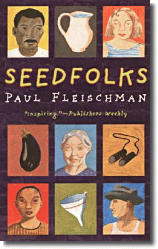When starting a blog, it seems to me there are two things worth agonizing over. One of these is your blog’s first entry—your drop-kick into the see-all, tell-all world of the blogosphere. The other is your blog’s name, which needs to be clever, catchy, and suggestive of your blog’s content. What it shouldn’t be are the names my wordsmithy friends and I came up with in our first few naming attempts. Excerpts from literary quotes? Too obscure. References to particular books? Too specific. Variations of my own name? Either too ridiculous (“Alison Also Rises”) or too… suggestive (“Alison Wonderland”). I believe we scraped the bottom of the blog-naming barrel when my boyfriend Gareth proposed “Clifford the Big Red Blog,” but at least that one got us laughing!
At last, inspiration struck in the form of “ShelfTalker,” a “shelf talker” being a piece of paper or cardstock we booksellers attach to a shelf in order to call attention to a particular book or books. Shelf talkers sometimes feature marketing materials prepared by a publisher or—as is the case at my bookstore—handwritten book reviews.
My intention with ShelfTalker is to both resemble a shelf talker (by calling attention to particular books) and be a shelf talker, by talking about all things book-industry-related. I hope too that you will make of me some kind of “shelf listener” by commenting on my remarks.
I can just see my first reader comment: “Thank you for not naming your blog something as lame as ‘Shelf Listener.’ “
On the topic of lame names, I’ve been wondering: Why am I suddenly seeing publishers change the titles of underperforming hardcovers when these books are reissued in paperback? This is a phenomenon I’ve observed with three novels in the past few months, and while three instances do not make a trend, I’m worried about the precedent this is setting.
The three novels I’ve recently purchased for our store that were apparently (in the eyes of their publishers) lamed by their own names are: Naughts and Crosses by Malorie Blackman, now appearing in paperback as Black and White; Gideon the Cutpurse by Linda Buckley-Archer, soon to appear in paperback as The Time Travelers; and Olivia Kidney and the Exit Academy by Ellen Potter, coming soon to a bookshelf near you as a paperback entitled Olivia Kidney Stops for No One.
I don’t fault the publishers of these books for wanting the sales of these books to improve. I do, however, question changing a book’s title in order to achieve that goal. From a marketing standpoint this seems like an expensive move, as it unravels any name recognition you may already have established for the book under its original title. Those teens who read about Naughts and Crosses when it first appeared read about a book called Naughts and Crosses, not Black and White. Those kids who’ve heard their friends talk about Gideon the Cutpurse haven’t heard a word about The Time Travelers. Why make your marketing team start the buzz all over again?
|

|

|
|
Then
|
Now
|
I find Philomel’s change for Olivia Kidney an especially strange one, as the book is the second title in a series. If you were going to boost the interest in a series, wouldn’t you change the title for the first book (if any) or rebrand the entire series? Rebranding a sequel seems, well… pointless, really. And confusing. I can already see the Olivia Kidney fans I’ve cultivated at our store rushing to the cash register with a copy of Olivia Kidney Stops for No One, only to get home and discover that they already read it, under what was arguably a catchier, more intriguing title.
As for Simon and Schuster’s name changes for Naughts and Crosses and Gideon the Cutpurse, I personally suspect that both books were less victim to poor titles than to unfortunate cover designs. The jackets of both books gave readers no indication of what each might be about and falsely suggested the tone of each book (bland and/or very serious). Don’t get me wrong, Gideon the Cutpurse had a more elegant package than almost any novel I’ve seen to date, but elegant often does not translate to kid-friendly, and I certainly don’t think elegant fits with either the tone of this book’s writing or with the thrilling notion of time travel.
Time travel will now certainly be on the minds of the kids who pick up Linda Buckley-Archer’s novel, as the title The Time Travelers leaves no room for doubt. But I also feel it leaves no room for intrigue. And I would argue that the same is true for Black and White, a title that calls to mind a bland nonfiction book about either race, photography or newspapers.
I have the utmost respect for the work of these two publishers, as they continually produce wonderful books. I just think it would be best to let wonderful (and even less than wonderful) books keep the names they were originally given. Find some other way, please, to reinvent the wheel—preferably one that doesn’t confuse or bewilder readers.














